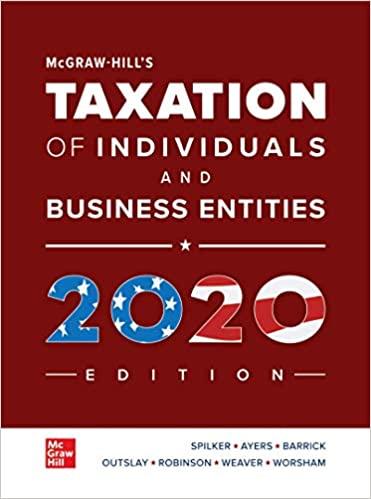55. Kirk and Lorna Newbold purchased a new home on August 1 of year 1 for $300,000....
Question:
55. Kirk and Lorna Newbold purchased a new home on August 1 of year 1 for $300,000. At the time of the purchase, it was estimated that the real property tax rate for the year would be
.5 percent of the property’s value. Because the taxing jurisdiction collects taxes on a July 1 year-end, it was estimated that the Newbolds would be required to pay $1,375 in property taxes for the property tax year relating to August through June of year 2 ($300,000 ×for investment, what is his taxable income after taking property taxes into account?
54. Craig and Karen Conder purchased a new home on May 1 of year 1 for $200,000. At the time of the purchase, it was estimated that the real property tax rate for the year would be 1 percent of the property’s value. How much in property taxes on the new home are the Conders allowed to deduct under each of the following circumstances? Assume the Conders’
itemized deductions exceed the standard deduction before considering property taxes and the property tax is the only deductible tax they pay during the year.
a. The property tax estimate proves to be accurate. The seller and the Conders paid their share of the tax. The full property tax bill is paid to the taxing jurisdiction by the end of the year.
b. The actual property tax bill was 1.05 percent of the property’s value. The Conders paid their share of the estimated tax bill and the entire difference between the 1 percent estimate and the 1.05 percent actual tax bill and the seller paid the rest. The full property tax bill is paid to the taxing jurisdiction by the end of the year.
c. The actual property tax bill was .95 percent of the property’s value. The seller paid their share of taxes based on the 1 percent estimate and the Conders paid the difference between what the seller paid and the amount of the final tax bill. The full property tax bill is paid to the taxing jurisdiction by the end of the year.
55. Kirk and Lorna Newbold purchased a new home on August 1 of year 1 for $300,000. At the time of the purchase, it was estimated that the real property tax rate for the year would be
.5 percent of the property’s value. Because the taxing jurisdiction collects taxes on a July 1 year-end, it was estimated that the Newbolds would be required to pay $1,375 in property taxes for the property tax year relating to August through June of year 2 ($300,000 ×
.005 × 11/12). The seller would be required to pay the $125 for July of year 1. Along with their monthly payment of principal and interest, the Newbolds paid $125 to the mortgage company to cover the property taxes. The mortgage company placed the money in escrow and used the funds in the escrow account to pay the property tax bill in July of year 2. The Newbolds’ itemized deductions exceed the standard deduction before considering real property and they don’t pay any other deductible taxes during the year.
a. How much in real property taxes can the Newbolds deduct for year 1?
b. How much in real property taxes can the Newbolds deduct for year 2?
c. Assume the original facts, except that the Newbolds were not able to collect $125 from the seller for the property taxes for July of year 1. How much in real property taxes can the Newbolds deduct for year 1 and year 2?
d. Assume the original facts, except that the tax bill for July 1 of year 1 through June 30 of year 2 turned out to be $1,200 instead of $1,500. How much in real property taxes can the Newbolds deduct in year 1 and year 2?
Step by Step Answer:

Taxation Of Individuals And Business Entities 2020
ISBN: 9781259969614
11th Edition
Authors: Brian Spilker, Benjamin Ayers, John Robinson, Edmund Outslay, Ronald Worsham, John Barrick, Connie Weaver





